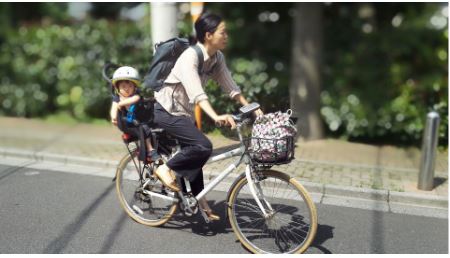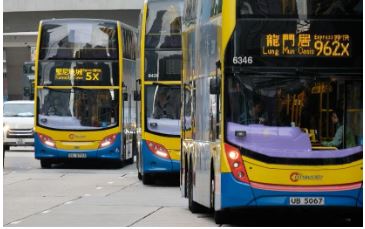In praise of trains, buses, and bicycles By GEORGE BRAINE
 Recently, while taking a walk in my neighborhood in Sapporo, Japan, a mother and a son passed me on a bicycle. The mother was riding, and the son, about three years of age, was safely belted to a seat in the rear. They appeared to be happy, chatting about something that made them smile. Once again, I found this, a scene that I witness often, charming.
Recently, while taking a walk in my neighborhood in Sapporo, Japan, a mother and a son passed me on a bicycle. The mother was riding, and the son, about three years of age, was safely belted to a seat in the rear. They appeared to be happy, chatting about something that made them smile. Once again, I found this, a scene that I witness often, charming.
Japan is a wealthy country. In my neighborhood, some households own three cars. But, many people also ride bicycles. Middle school and high school students, working men and women, housewives, the elderly. Wide pavements and bicycle lanes encourage the practice. A habit children have gained while riding with their mothers is carried onto adulthood.
Compare this to Sri Lanka, a poor country, where bicycles (till the economic crisis hit recently) were a rarity on our roads. For one thing, bicycles are just above pedestrians in the pecking order, motorcycles, cars, vans, buses and trucks appearing to have the right of way. In my ancestral village, perhaps five students rode bicycles to school. Years ago, when I schooled in Negombo, hundreds of students and even teachers would stream into the school every morning on their bicycles, a sight I recall with a nostalgia for simpler times.

Motorcycles and scooters have replaced bicycles. In my village and in areas where “foreign money” is received from family members working abroad, the transition from bicycles to scooters and motorcycles began about 30+ years ago. The remittances changed lifestyles, and scooters and motorcycles became status symbols. (Think of the old song, which went “Bicycale, bicycale, duppath apage bicycale”! Bicycles were for poor people.) A household may even have three of them: a motorcycle for the husband, and scooters for the wife, grown children, or an elderly parent. Gradually, bicycles became a rare sight.
In Sri Lanka, public transport is the last resort for most people. Anyone who has taken a crowded, filthy train, traveling on a footboard during peak hours, or has taken a loud, sardine-packed, belching bus, knows how lowly our public transport is. But compare that with Hong Kong, another wealthy place like Japan, where public transport is much loved and heavily used. The mass transit railway (MTR), light trains, buses, mini-buses, trams, ferries, and taxis provide quick and efficient services, at all hours. As a result, in the vehicles per capita count, 1000 Hong Kongers own only 92 vehicles. (The figure for the USA is 898.)

The MTR has a wide network throughout Hong Kong, with 92 stations. The trains are electrified, air conditioned, clean, and their on-time arrival is 99%. A mark of its popularity is that, in a population 7.5 million, nearly 5 million MTR rides are completed every day. The fares are reasonable. As a senior citizen, I can ride the 262-kilometer MTR network for the whole day for just HK$2 (that is, about Rs. 90/).
These trains – like the air conditioned, comfortable buses – are washed every day and cleaned at the end of each journey. The widely used stored value “Octopus” card eliminates the need to buy a ticket for each journey. Train and bus conductors are not needed. When I retired in Hong Kong, I gave my car away and relied entirely on public transport, and became a happy commuter instead of a driver.
The Covid experience and the economic crisis has taught us the value of national self-reliance. Spending millions of hard earned or borrowed foreign exchange to import motor cycles and cars, running on imported oil, will not lessen the national burden. The government has taken a step in the right direction by halting the import of motor cycles. What I suggest is a 3-year moratorium on the import of motor cycles, three-wheelers, and cars. Not even duty free vehicles should be allowed. Our roads are jammed with vehicles already.
In their place, with the money saved, buses and trains can be upgraded. Comfortable seats, air conditioning when possible, and law-abiding drivers (not drug addicted speed fiends) will certainly make bus journeys more attractive and comfortable. The same goes for trains. Clean trains with comfortable seats and hygienic toilets, that run on time, is not much to ask for.
In getting back to the basics, bicycle riding could be made safe and even fashionable, especially in urban areas. Bicycle lanes on major roads is a good idea.
I like to end with a recollection of my childhood. At the age of six, I took a public bus from Dankotuwa to Negombo to attend school, traveling 14 km each way. Three years later, I took the train from Nattandiya to Negombo, a distance of 45 km each way. The buses were crowded and open sided, and the trains were pulled by smoke belching steam engines. But the romance of those journeys is still etched in my mind. Today’s children, packed in school vans or traveling in comfortable cars if they are affluent, have no idea of what they are missing.







